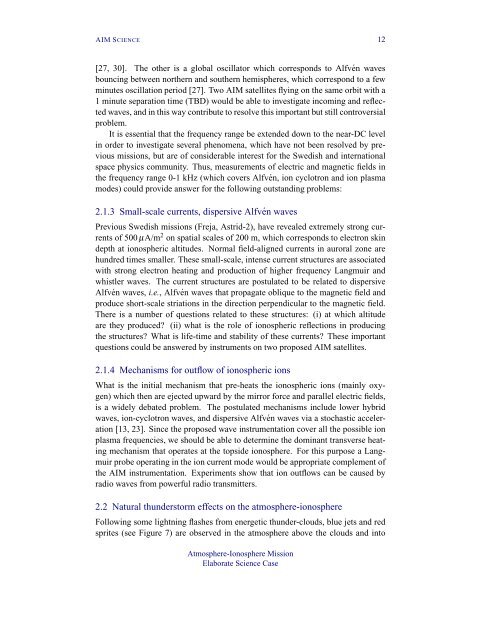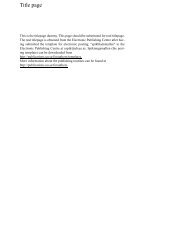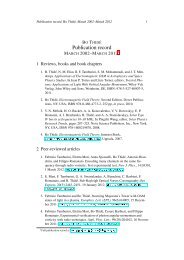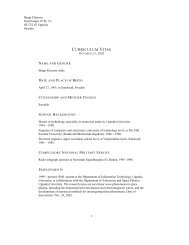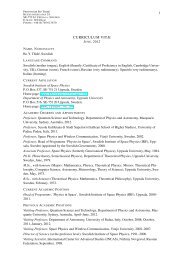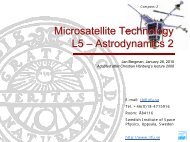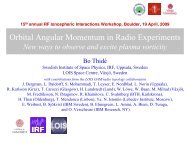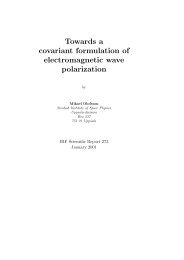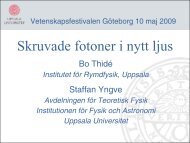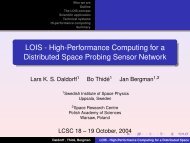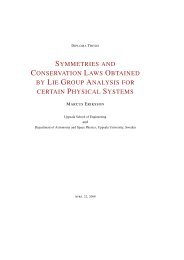Atmosphere-Ionosphere Mission - Swedish Institute of Space ...
Atmosphere-Ionosphere Mission - Swedish Institute of Space ...
Atmosphere-Ionosphere Mission - Swedish Institute of Space ...
You also want an ePaper? Increase the reach of your titles
YUMPU automatically turns print PDFs into web optimized ePapers that Google loves.
AIM SCIENCE 12<br />
[27, 30]. The other is a global oscillator which corresponds to Alfvén waves<br />
bouncing between northern and southern hemispheres, which correspond to a few<br />
minutes oscillation period [27]. Two AIM satellites flying on the same orbit with a<br />
1 minute separation time (TBD) would be able to investigate incoming and reflected<br />
waves, and in this way contribute to resolve this important but still controversial<br />
problem.<br />
It is essential that the frequency range be extended down to the near-DC level<br />
in order to investigate several phenomena, which have not been resolved by previous<br />
missions, but are <strong>of</strong> considerable interest for the <strong>Swedish</strong> and international<br />
space physics community. Thus, measurements <strong>of</strong> electric and magnetic fields in<br />
the frequency range 0-1 kHz (which covers Alfvén, ion cyclotron and ion plasma<br />
modes) could provide answer for the following outstanding problems:<br />
2.1.3 Small-scale currents, dispersive Alfvén waves<br />
Previous <strong>Swedish</strong> missions (Freja, Astrid-2), have revealed extremely strong currents<br />
<strong>of</strong> 500 µA/m 2 on spatial scales <strong>of</strong> 200 m, which corresponds to electron skin<br />
depth at ionospheric altitudes. Normal field-aligned currents in auroral zone are<br />
hundred times smaller. These small-scale, intense current structures are associated<br />
with strong electron heating and production <strong>of</strong> higher frequency Langmuir and<br />
whistler waves. The current structures are postulated to be related to dispersive<br />
Alfvén waves, i.e., Alfvén waves that propagate oblique to the magnetic field and<br />
produce short-scale striations in the direction perpendicular to the magnetic field.<br />
There is a number <strong>of</strong> questions related to these structures: (i) at which altitude<br />
are they produced? (ii) what is the role <strong>of</strong> ionospheric reflections in producing<br />
the structures? What is life-time and stability <strong>of</strong> these currents? These important<br />
questions could be answered by instruments on two proposed AIM satellites.<br />
2.1.4 Mechanisms for outflow <strong>of</strong> ionospheric ions<br />
What is the initial mechanism that pre-heats the ionospheric ions (mainly oxygen)<br />
which then are ejected upward by the mirror force and parallel electric fields,<br />
is a widely debated problem. The postulated mechanisms include lower hybrid<br />
waves, ion-cyclotron waves, and dispersive Alfvén waves via a stochastic acceleration<br />
[13, 23]. Since the proposed wave instrumentation cover all the possible ion<br />
plasma frequencies, we should be able to determine the dominant transverse heating<br />
mechanism that operates at the topside ionosphere. For this purpose a Langmuir<br />
probe operating in the ion current mode would be appropriate complement <strong>of</strong><br />
the AIM instrumentation. Experiments show that ion outflows can be caused by<br />
radio waves from powerful radio transmitters.<br />
2.2 Natural thunderstorm effects on the atmosphere-ionosphere<br />
Following some lightning flashes from energetic thunder-clouds, blue jets and red<br />
sprites (see Figure 7) are observed in the atmosphere above the clouds and into<br />
<strong>Atmosphere</strong>-<strong>Ionosphere</strong> <strong>Mission</strong><br />
Elaborate Science Case


